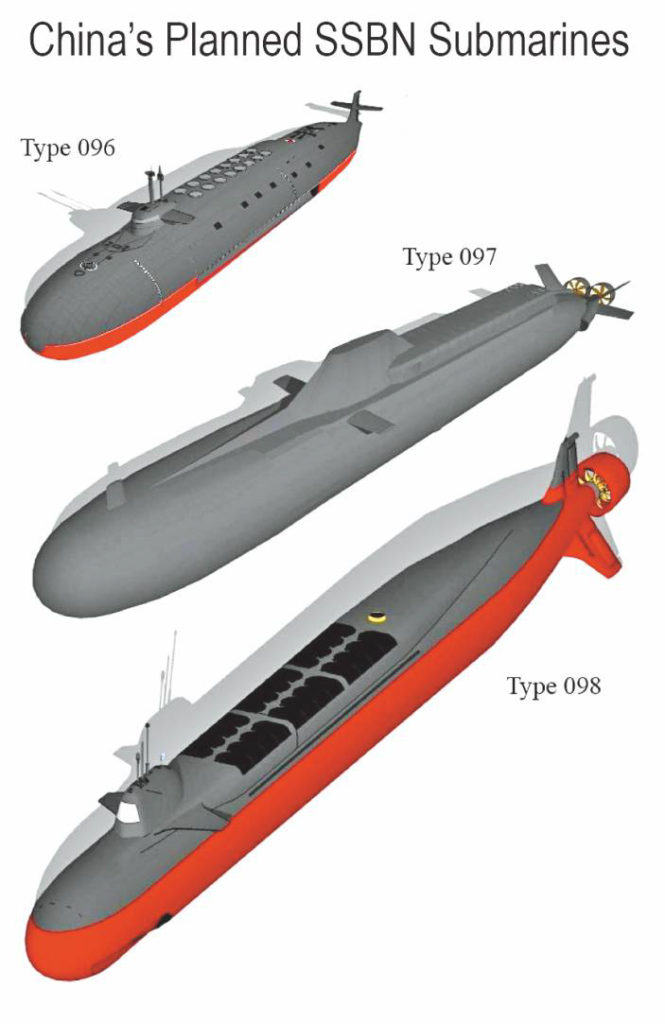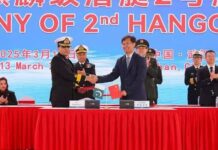China Shipbuilding Industry Corporation (CSIC) announced the commissioning of a new strategic nuclear-powered submarine to enhance its comprehensive nuclear deterrent force, on 22 April.
The Global Times article did not reveal neither the submarine’s name nor its type. However, the description that read that it was a “strategic” asset suggested that it could refer to a nuclear ballistic missile-carrying submarine (SSBN). Analysts considered it unlikely that this was the first of the next-generation Type 096 SSBNs submarine.
The article was written to reflect recent achievements of the People’s Liberation Army Navy (PLAN) in celebration of the 71st anniversary of the establishment of the naval service, the report refers to “new weapons” entering service including the Type 055 destroyer, the first domestically built aircraft carrier, and new anti-submarine patrol aircraft (the KQ-200), as well as the new submarine.
Type 096 SSBN
The period between launch and commissioning of the first Type 096 submarine is estimated to be up to four years and a new design has not yet become visible in satellite imagery.
The 2017 Annual Report to the US Congress on China’s military power by the US Defense Department (DoD) maintains that Bejing’s next-generation nuclear submarine, Type 096, will likely begin construction in the early 2020s, and will reportedly be armed with the JL-3, a submarine-based ballistic missile.
The submarine is a key weapon to the country’s nuclear warfare capability. Only the US and Russia have the real ‘nuclear triad’ (consisting of ballistic missiles, strategic nuclear submarines and strategic bombers), but sooner or later, China will have it as well.
The DoD report also forecast that by 2030, Being could develop a new variant of the Shang-class (NATO code) Type 093B, which would not only improve the PLA’s anti-surface warfare capability but also provide it with a more clandestine land-attack option.
Sea-based Nuclear Deterrent
Consistent with Chinese nuclear doctrine and defense white papers, Chinese strategic nuclear forces are meant to comprise a “lean and effective deterrent force” for the “flexible use of different means of deterrence” for “safeguarding national sovereignty and security.”
If China adheres to its declared “no first use” policy and “self-defensive nuclear strategy,” its nuclear arsenal must be able to survive a first strike. China’s ballistic missile submarine force is likely meant to augment its solid-fuel, road-mobile, land-based intercontinental ballistic missiles (ICBMs), which can be readily hidden in the vastness of China’s territory. Given the survivability of its land-based ICBM forces, some argue that SSBNs might be an expensive insurance policy. Beijing is working to field a credible SSBN force. To do so China must make strides in terms of command, control, communications, and quieting technologies.
The challenges of fielding a credible sea-based nuclear deterrent for China are threefold.
• Chinese SSBNs must have operational stealth, meaning they must be difficult to find in order to evade detection and tracking by adversaries.
• China must have a reliable long-range submarine-launched ballistic missile (SLBM) capable of striking a target at intercontinental ranges with a nuclear payload.
• There must be a reliable and survivable communications, command, and control system in place to ensure that China’s national command authority can communicate with its SSBNs after the country has suffered a first strike.
Previous Attempts
China’s first attempt at an indigenous SSBN resulted in a single Xia-class submarine that suffered from limited missile range and high sound emissions. The vessel allegedly never left port with nuclear weapons on board. The successor Jin-class (Type 094), which carries the JL-2 SLBM, represented a significant improvement. The Jin-class/JL-2 platform “represents China’s first credible, sea-based nuclear deterrent,” according to the US Department of Defense’s 2016 Annual Report to Congress on China’s military.
There are four Jin-class SSBNs currently operational and another two being outfitted at Huludao Shipyard.
Nuclear Triad
China has a nascent nuclear triad, but one that remains limited primarily by range, arsenal size, and operational experience. China’s estimated 50 H-6K bombers, with a range of about 2,000 miles, are only able to deliver a payload to targets in nuclear weapons states as Russia, U.S. territory Guam, and the Indian subcontinent. Aerial refueling would only marginally extend bomber range because China does not have tanker aircraft deployed outside of the Chinese mainland; however, tankers staged from newly constructed Spratly Island airfields in the South China Sea could change this equation.
China currently fields approximately 50 to 60 ICBMs, including an estimated 24 solid-fueled, road-mobile CSS-10 Mod 2s (DF-31A). The CSS-10 Mod 2 has a range exceeding 11,200 km and can reach most locations within the continental United States. These rely upon hardened silos, road mobility, and according to some reports underground railways to ensure their survivability. In addition to its fleet of 14 Ohio class SSBNs, the U.S. nuclear triad boasts 20 B-2A and 70 B-52H long-range bombers, and at least 450 ICBMs. Russian nuclear forces include 13 SSBNs of various classes and 78 Tu-160 and Tu-95 long-range bombers, and at least 332 ICBMs.
PLAAN Submarine Force
The People’s Liberation Army Navy Submarine Force (PLANSF) is the submarine service of the People’s Liberation Army Navy. Currently, PLANSF operates a fleet of 68 submarines which include nuclear as well as conventional submarines.
Nuclear-powered ballistic missile submarines
The PLAN currently operates two classes of ballistic missile submarines:
• Type 094 submarine (NATO designation Jin-class).
• Type 092 submarine (NATO designation Xia-class).
The Type 092 submarine (Xia-class), was commissioned by 1983. Its primary weapon is the JL-1 SLBM, with 12 launch tubes, as well as six 533 mm tubes for self-defence. The Xia is now carrying an improved missile, the JL-1A that is alleged to have longer range.
The Type 094 submarine (Jin-class) features 12 launch tubes for the longer ranged JL-2 missile, which has an 8,000 km range that can carry 3 to 4 MIRVs. The 094 would be permitted to patrol nearer Chinese waters, with the ability to launch its missiles against continental US targets.
Nuclear-powered fleet submarines
The PLAN currently has two types of nuclear-powered attack submarines in service:
• Type 093 submarine (NATO designation Shang-class).
• Type 091 submarine (NATO designation Han-class).
The Type 091 submarine (Han-class) has mostly operated in local waters, but since the 1990s, they have been used more aggressively.
Little information has emerged about the Type 093 submarine (Shang-class), but it maybe comparable to the Russian Victor III-class, signifying a significant step forward for Chinese nuclear attack submarines.
China is constructing a major underground nuclear submarine base near Sanya, Hainan. The Daily Telegraph on 1 May 2008 reported that tunnels were being built into hillsides which could be capable of hiding up to 20 nuclear submarines from spy satellites.
Conventionally-powered attack submarines
The PLAN currently operates four different classes of conventional submarines:
• Type 039A submarine (NATO designation Yuan-class).
• Type 039 submarine (NATO designation Song-class).
• Kilo-class submarine (NATO designation Kilo-class).
• Type 035 submarine (NATO designation Ming-class).
The Type 035 submarine (Ming-class), first commissioned in 1974, is based on the Type 033. It could be considered as China’s first indigenously designed submarine, despite its similarities to the Russian Romeo-class. At least 17 hulls are still in service, with later hulls using modern sonar systems, including the French DUUX-5. The later hulls of the Ming-class may have been employed for testing air-independent propulsion (AIP), which would significantly reduce the noise level of the submarine.
Despite the purchase of 12 Kilo-class, the PLAN has continued to develop indigenous designs. The Type 039 submarine (Song-class) was first launched in 1994 with sea trials in 1995. By 2006 about 13 hulls have been confirmed to be built so far. The Song-class submarines are armed with torpedoes and a sub-launched variant of the YJ-8 anti-ship missile. An AIP system may be installed in the future.
The Type 039A submarine (Yuan-class) is the latest of China’s indigenous submarine. The hull seems to resemble Russian influences (as it is similar to the Kilo). The Yuan-class is likely fitted with an AIP system to achieve maximum silent operational capabilities and can be armed with advanced Russian and Chinese torpedoes and cruise missiles. This class of submarine is expected to have capabilities which surpass the Kilo and Song-classes considerably. Series production began late in 2007, with at least 17 boats identified so far and up to 3 more under construction.
Conventionally-powered ballistic missile submarine
Type 032 submarine (NATO designation Qing-class) – In service as technology testbed.
China has constructed the world’s largest conventional submarine – the Type 032, initially called the Type 043. Some reports claimed that the Type 032 submarine may be a cause for concern as a general purpose submarine, not only responsible for testing JL-2 ICBMs, but the design could also be fitted as an “aircraft carrier killer”, carrying anti-ship ballistic missiles. Thus far only one has been built, supporting the test platform interpretation – if more than one appeared, the “aircraft carrier killer” interpretation would begin to gain currency.
A photo was taken in July 2017. China’s Type 032 will be able to launch various weapons including the JL-2A submarine-launched ballistic missile [from tubes in the sail] and CJ-20A cruise missiles and the YJ-18 anti-ship missile from tubes in the hull forward of the sail.



















